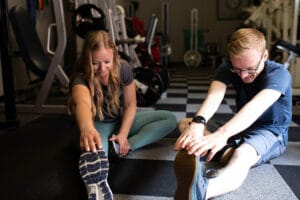Are you someone who loves to run outside, but the cold, harsh MN winters make it difficult to do so? Or maybe you suffered a running injury that has healed, but you haven’t run outside since. We understand these hardships during this time of year and would like to help you transition into spring running with ease! Returning to outdoor running with a plan, preventing injuries with strength training, and finding a running/walking group will make the process back into running easier and more effective. If running isn’t your thing, you can also apply these concepts to other forms of cardiovascular exercise.
Running with a Plan
Let’s face it, running outside all year in Minnesota isn’t for everyone and that’s okay. Depending on the year, “Spring” weather can be drastically different from late March to late June. Ever heard of the term “False Spring”? That was a few weeks ago when it was almost 70°F outside. The rain and snow can make running outside more difficult than it needs to be. With this in mind, try to plan your run on the best day of  the week so you can stay consistent. Even if you only run once that week, that’s okay, maybe next week’s weather will allow you to run more. Start by looking at the weather at the beginning of the week and then make a tentative plan. If you start with introducing 1 day of running per week while the weather is changing, it can create a snowball effect (pun intended) that can lead to 2 days per week by summer time.
the week so you can stay consistent. Even if you only run once that week, that’s okay, maybe next week’s weather will allow you to run more. Start by looking at the weather at the beginning of the week and then make a tentative plan. If you start with introducing 1 day of running per week while the weather is changing, it can create a snowball effect (pun intended) that can lead to 2 days per week by summer time.
Run with Others

Running alone takes a lot of motivation and sometimes we all need that extra push from a friend to get started. If you feel this same way, chances are you aren’t alone! You might know of people in your life that are looking to start running, but maybe you don’t. Facebook has a lot of groups that are helpful in finding others that share the same goal. If you are interested in meeting other runners at Titanium Performance, you can follow us on Strava via this link: https://www.strava.com/clubs/titaniumperformance
Preventing Running Injuries
Anyone who has ran before has probably felt aches and pains during or after the run. Running shoes, foot contact, running surface, and strength of muscles can all play a role. If you use shoes that support your arch, less contact force will be placed on the foot during each step. Be sure to check your shoes inserts for wear and tear before the start of outdoor running. Next time you run try using either a forefoot or flatfoot strike to reduce the amount of force placed on the ankle, knee, and hip joints. When out for a run try to avoid concrete surfaces; woodchips, grass, or gravel help reduce contact force. Finally, try strengthening the muscles that surround each joint by performing hip extension/flexion, knee extension/flexion, and ankle plantarflexion/dorsiflexion.
Are you having a hard time starting a spring running routine? Want help from an experienced trainer? Try a FREE introductory session with a Titanium Performance Trainer!
Written by: Matt Lerch



